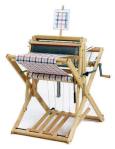Knits!
Knit fabrics are used many of the comfy clothes popular today. Your sweaters, t-shirts, and yoga pants are all knits. So are some dresses. Knits have a number of qualities that make them super easy to identify. But first, I would like to take a second and explain their unique creation.
Knits are created by interlocking loops of yarns. This used to be done only by hand but is now done on knitting machines (though tons of people so still hand knit). Either way you do it the two techniques are the same. Each interlocking loop is created by a single stitch (a stitch is created when you put a new loop of yarn through an old loop and then cast off). Then these stitches make up an entire garment or piece of fabric. The two major types of knits are weft knits and warp knits. (more…)
Learn About: Woven Fabrics
This post on the nitty-gritty details of woven fabrics is a part of series by Jacqueline Gross, our stateside connection (she hails from Michigan) and resident fabric and textile guru. Check back (or subscribe to our feed) to learn about knits, and common fabrics.

Knowing the type of fabric you are using is important! (You can tell because I put an exclamation point). The weight, stretch, as well as, other important fabric qualities will affect the look of your finished project. In the next few weeks, I’ll be taking you through the ins and outs of fabrics. Today, we look at woven fabrics.
When you think woven fabrics think of looms. Woven fabrics are produced on looms. Understanding the creation of woven fabrics helps us to understand their nature. A woven fabric is created when you have warp yarns and filling yarns. Weaving (what you do on a loom) is interlacing these two yarns. There are three basic types of weaves, and regardless of the complexity of the weave they still fall under these three classifications. They are: plain weave, satin weave, and twill weave.
Dyeing with Natural Dye
Going green is an active part of our lifestyle today, so why not take that a step further and move it into the wilderness. By that I mean dyeing fabric with natural dye (duh!). Summer is ending and fall edging its way in. This is the season of harvest, so after you are done picking apples and blueberries, let’s talk clothes.
People have been dyeing with natural dyes forever. I mean that is how it all began until we realized that we had alternatives… called chemicals. So go on a nature-hike, explore the wild, or go online and order natural dye, but you have to try it out!
Figuring out Fabric: The Burn Test
 Problem: You have some fabric, but you don’t know what it is made out of…
Problem: You have some fabric, but you don’t know what it is made out of…
Solution: The burn test
You can often figure out what type a fabric is by doing what’s called a burn test. As the name implies, you burn a small section of your fabric. Because most types of fiber react to heat in a unique way, the burn test is used to figure out your fabric. This can be a fun test – especially if you like to burn things.
Sewing with Lightweight Fabrics
Summer is almost here. Finally!

Put away the fuzzy fleece and make room for summery sheers. Have a summer wedding to attend? Try a shawl in a pretty organza. For those hot summer nights, try making a one of a kind night dress from a sexy silk. Though these fabrics make our summer wardrobe bloom, since they are so delicate there are special precautions we should take when sewing with them. Here are a few tips:
• Use a fine point needle
• Set the machine for the smallest stitch
• Use silk pins for pinning
• When pinning place a paper cutting board under the fabric to keep it from sliding.
• Use fine cotton covered polyester thread or lingerie thread.
• Use a “baby hem” or a rolled hem.
• Use small buttons, covered snaps and hook and eyes for closures. Use a nylon zipper if you must as it is the lightest.
Happy Sewing!
-Tajah-
So, Where Do You Get All this Stuff?
I’m sure at some point or the other we have all been in a basic fabric store for some reason or the other. But as with any hobby there are always those “hidden gems”.
The craft and sewing industry has many of those because there are so many options for fabrics. Think about it. Look around you. You maybe in your living room, bedroom or office. How many things are made from fabric? Seat cushions, curtains, placemats, your sofa, your favorite blanket and of course your own clothes. So get out there and find those hidden gems, don’t settle for your neighborhood fabric store, trust me you’re missing out. Toronto has an unlimited number of textile suppliers.
These are just a few links of some of the ones that really caught my eye. But it’s just the tip of the iceberg.
http://www.designerfabrics.ca/shop/scripts/default.asp
http://www.leostextiles.com/
http://www.elegancefabrics.com/stores.htm
http://www.textilehousecanada.com/contactUs.html
http://www.threadcountinc.com/index.asp
Toronto’s Fashion District (Spadina Avenue, from Queen to Front St) boasts wide assortments of fabric, notions, and leather and fur shops.
-Tajah-
Sewing Green!
The state of the environment is one of the largest issues facing us today. I’m sure each and every one of us tries to implement eco-friendliness in our everyday lives to do our part for the environment. There are actually ways for us to sew green in addition to traditional eco-friendly practices. A few ideas are:
- Use fabrics made from recycled materials, fabrics made from natural materials, certified organic cotton, silk, fine linen, as well as the coarse but durable fibres of hemp, ramie, and jute.
- Look for un-dyed or botanically dyed fabrics if possible.
- Sew a cotton or linen tote to take to the market instead of using the store’s plastic and paper bags.
- Donate unwanted fabric and supplies to arts classes, schools and community centers.
- Consider care instructions when choosing fabrics. Does it need to be dry-cleaned? Washed in hot water?
Type “sew green” into any search engine and you will come up with endless ways to do your part!
-Tajah-
